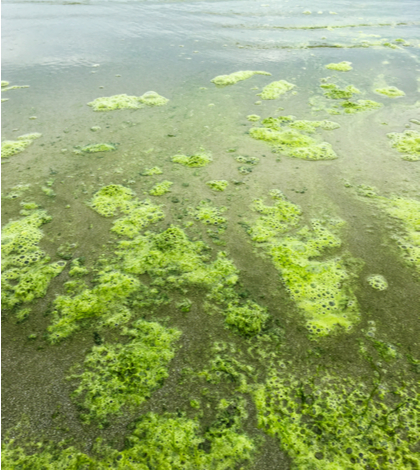Two have been found to have blue-green algae (cyanobacteria) and state water authorities are encouraging people to avoid contact with water at Big Bear Lake and Silverwood Lake’s Cleghorn Beach.
The State Water Resources Control Board (SWRCB) and the Santa Ana Regional Water Quality Control Board reported the presence of the harmful algal bloom (HAB) at Big Bear Lake on Oct 15 based on lab results of water samples collected on Sept. 19 at several locations on the lake where HABs were detected near the shoreline. The Department of Water Resources (DWR) reported finding the blue-green algae (cyanobacteria) at Silverwood Lake’s Cleghorn Beach on Oct. 16.
Recreational activities are common at both lakes. Whereas Big Bear Lake is best known as a popular fishing destination and for boating activities Silverwood Lake is known not only for boating but also for other water-contact recreation and sporting activities. Whereas Silverwood Lake’s Cleghorn Beach is currently not considered safe for these activities, the nearby Sawpit Beach remains at a caution level.
Exposure to toxic blue-green algae, also known as cyanobacteria, can cause eye irritation, allergic skin rash, mouth ulcers, vomiting, diarrhea, and cold- and flu-like symptoms. Swimmers are urged to stay away from algae and scum in the water, and parent should keep children away from algae in the water or on the shore.
Pets and livestock can be especially susceptible to sudden illness from HABs because they tend to drink while in the water and lick their fur afterwards. Keep pets away from the water with blue-green algae or anywhere that has been identified with HABs. If a pet does come in contact with a HAB rinse the pets in clean water to remove algae from their fur.
Before consuming any fish caught at a lake with HABs, it is important to throw away the fish guts and clean fillets thoroughly with tap water. However, it’s best to not eat fish or shellfish from infected waters in spite of your best efforts to clean them. This is based on the potential health risks posed by the algal organisms called cyanobacteria and the level of toxins measured in water samples.
Harmful algal blooms appear as bright to dull-green material near the water surface or floating, sometimes resembling spilled paint. Cyanobacteria can form thick algal mats, scum or form foam on the water surface and accumulate on the shore. Bloom conditions can change rapidly, and wind and waves may move or concentrate the bloom into different regions of the reservoir.
Additionally, recommendations from the DWR is that you avoid wading, swimming, or jet or water skiing in water containing algae blooms, scum, or mats. Do not drink, cook, or wash dishes with untreated surface water from these areas under any circumstances. Common water purification techniques such as camping filters, tablets, and boiling do not remove cyanobacteria toxins.
If you think that you, a family member, friend, pet, or livestock might have been poisoned by blue-green algae toxins get medical treatment immediately. Be sure to alert medical professionals to the possible contact with blue-green algae. Also, make sure to contact the local county public health department.
For additional information on HABs contact one of the following:
- California Department of Public Health at: https://www.cdph.ca.gov/Programs/CCDPHP/DEODC/EHIB/EAS/Pages/HABs.aspx
- State Water Resources Control Board at: https://mywaterquality.ca.gov/habs/what/index.html
- CA Office of Environmental Health Hazard Assessment at: https://oehha.ca.gov/ecotoxicology/general-info/information-microcystins
- US Environmental Protection Agency: CyanoHAB website at: https://www.epa.gov/cyanohabs
- Centers for Disease Control and Prevention at: https://www.cdc.gov/habs/.
 California Water News Daily Your Source For Water News in California
California Water News Daily Your Source For Water News in California


